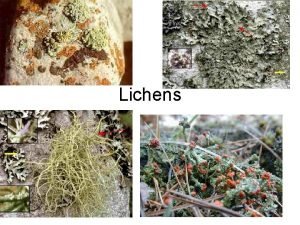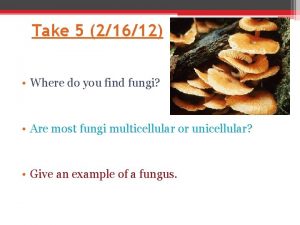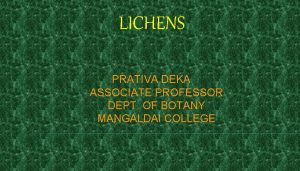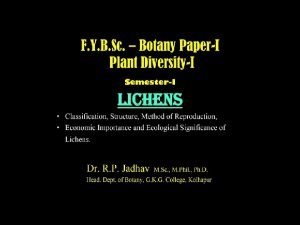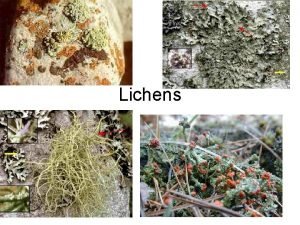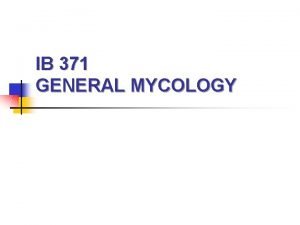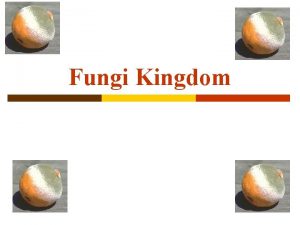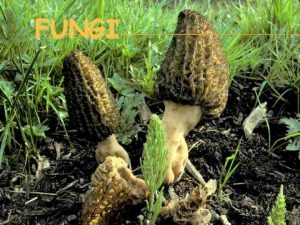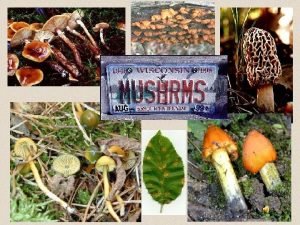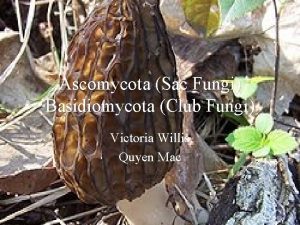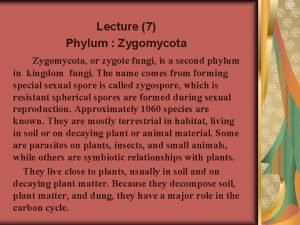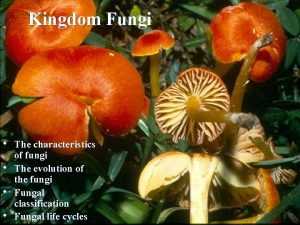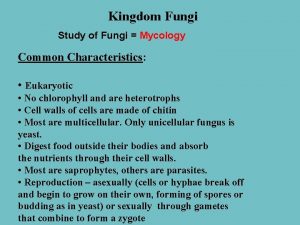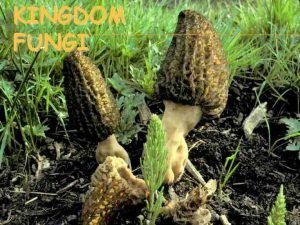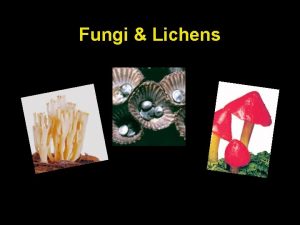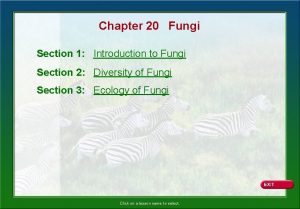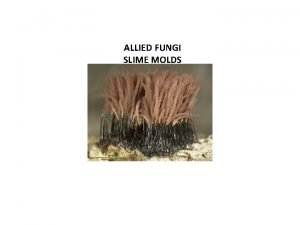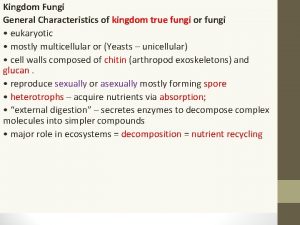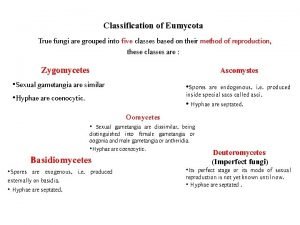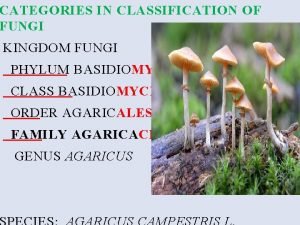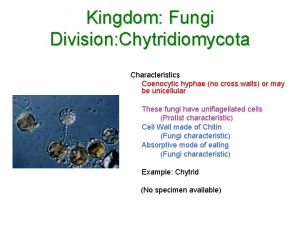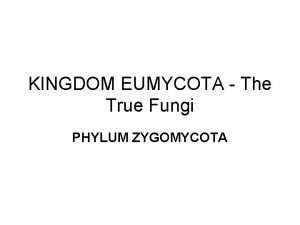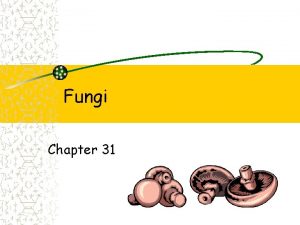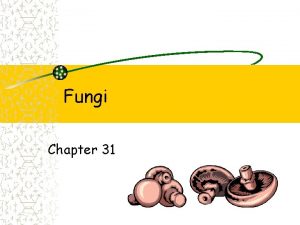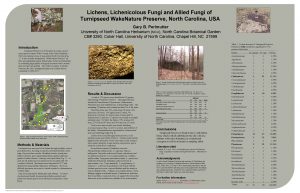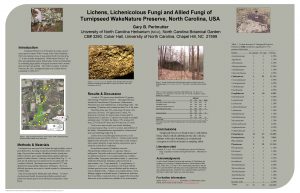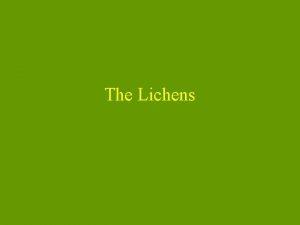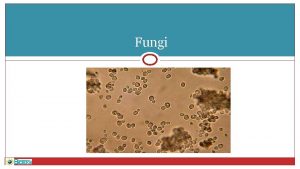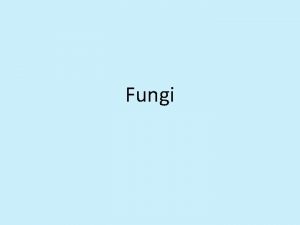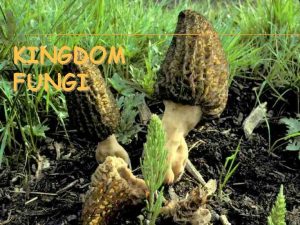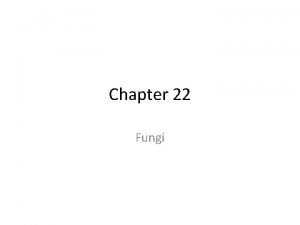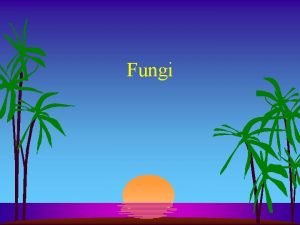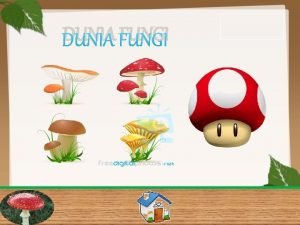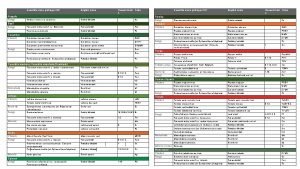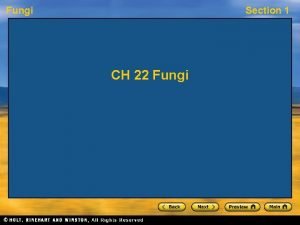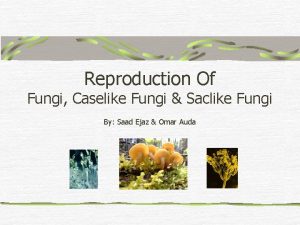Fungi Lichens I Characteristics of fungi A What
























- Slides: 24

Fungi & Lichens

I. Characteristics of fungi A. What are fungi? – Fungi (singular fungus) are eukaryotic heterotrophs that have rigid cell walls, like plants, but no chlorophyll

B. What do fungi eat? – Fungi must live on or near their food supply – Fungi get nutrients by secreting digestive juices and then absorbing the dissolved food

C. What are fungi made of? – Some single celled, most multi-cellular – Made up of chains of cells called Hyphae (singular hypha)

C. What are fungi made of? – hyphae grow together to form a twisted mass called a mycelium – Mycelium is usually hidden underneath the ground (can be up to 35 m across)

D. How do Fungi Reproduce? – Asexual 1. 2. 3. Hyphae break apart and each piece becomes a new fungus Budding – single cells split apart forming a new fungus Production of spores – – – Spores – small reproductive cells that are protected by a thick wall, spread by the wind Sporangia – spore cases Sexual 1. When special structures form to make reproductive cells

II. Kinds of Fungi A. Fungus are classified based on shape, and the way they reproduce B. Four main groups

1. Threadlike fungi • • Live in soil Decomposers Reproduce asexually by spores Reproduce sexually when hyphae from different fungi join together and grow into specialized sporangia

1. Threadlike fungi Example • Mold – a fungus that looks like wool or cotton

2. Sac Fungi • • Largest Group of fungi Consumers, Decomposers, Parasites Single celled reproduce asexually by budding Multi-celled reproduce sexually by forming a sac that develops the sexually produced spores • Ascus – reproductive structure formed by sac fungi

2. Sac Fungi • Examples • • • Yeast (single-celled) Dutch Elm Disease Powdery Mildew Truffles Morels

3. Club Fungi • Most known group of fungi • Consumers, Decomposers, Parasites • Reproduce sexually by growing special hyphae that form a basidia • Basidia - club-like reproductive structure formed by club fungi

3. Club Fungi • Examples • Mushrooms

3. Club Fungi • Examples • Mushrooms

3. Club Fungi • Examples • Mushrooms • Most of the fungus lives underground

3. Club Fungi • Examples • Mushrooms • • Most of the fungus lives underground Non-mushroom club fungi • Bracket fungi

3. Club Fungi • Examples • Mushrooms • • Most of the fungus lives underground Non-mushroom club fungi • • Bracket fungi Puffballs

3. Club Fungi • Examples • Mushrooms • • Most of the fungus lives underground Non-mushroom club fungi • • • Bracket fungi Puffballs Smuts

3. Club Fungi • Examples • Mushrooms • • Most of the fungus lives underground Non-mushroom club fungi • • Bracket fungi Puffballs Smuts Rusts

4. Imperfect Fungi • • • Includes species that don’t fit in other groups Parasites Reproduce asexually

4. Imperfect Fungi • Examples • • Athletes Foot Penicillium Cheese Producers Soy sauce Producers

Lichens


Answer the following questions about lichens using page 288 of your book Use complete sentences! 1. A lichen is a combination of what two organisms? 2. Because lichens produce their food through photosynthesis, are they a producer, consumer, decomposer or parasite? 3. What allows lichens to live in even the driest environments without drying out? 4. Why can lichens grow on rocks? 5. Give one example of how a lichen changes its surroundings in a way that allows other organisms to live there. 6. Why are lichens easily affected by air pollution?
 Lichen association
Lichen association The fungi basidiomycota are often used for making _____.
The fungi basidiomycota are often used for making _____. Characteristics of lichen
Characteristics of lichen Classification lichen
Classification lichen Lichen is an association of
Lichen is an association of Lichen as food
Lichen as food Symbiotic organism
Symbiotic organism Basidiomycota rusts and smuts
Basidiomycota rusts and smuts Are fungi eukaryotic
Are fungi eukaryotic Ascomycota examples
Ascomycota examples Zygote fungi
Zygote fungi Characteristics of fungi kingdom
Characteristics of fungi kingdom What is characteristics of fungi
What is characteristics of fungi Fungi kingdom characteristics
Fungi kingdom characteristics Characteristics of yeast
Characteristics of yeast Characteristics of club fungi
Characteristics of club fungi Chapter 20 section 1 characteristics of fungi
Chapter 20 section 1 characteristics of fungi Phagocystosis
Phagocystosis General characteristics of true fungi
General characteristics of true fungi Eumycota fungi
Eumycota fungi Fungi kingdom classification
Fungi kingdom classification Division of mushroom
Division of mushroom True fungi
True fungi Basidiomycota
Basidiomycota Basidiomycota sexual reproductive structures
Basidiomycota sexual reproductive structures
